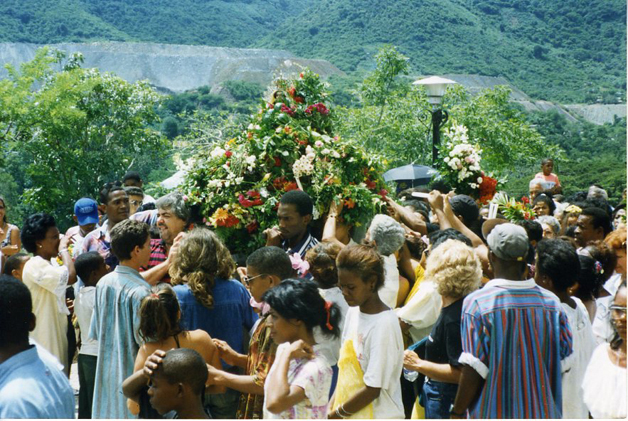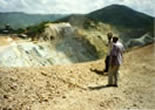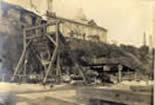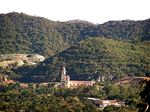
Procession with open mine quarry in the background, El Cobre, 1997.
  
Open quarry in El Cobre, 1997 (left); Mining works next to Sanctuary, c 1904 (center); Long distance view of Sanctuary surrounded by quaries, c. 1990s (right).
Click on thurmbnail to view full-size image.
|
 |
< 7 >
In the background of the procession of the Virgin (behind flowers) around the basilica, an open mine can be viewed. At the time, copper mining was still the town's main economic activity. Although the main association of El Cobre is with the Marian Sanctuary, the locality's mining history is an intrinsic part of the town's colonial, Republican and recent past during the Revolution. The very name of the town alludes to its copper mining history (el cobre means "copper") and the Virgin's name, la Virgen del Cobre, is also associated with the copper mines. Similarly, Santeria's Ochun is said to be the "owner" of copper.
The Marian shrine's foundational story stressed that the Virgin wanted her sanctuary built on top of the mountain of the mine. Old colonial local maps always inscribed both sites as landmarks. Relations between mining interests, the Sanctuary (or the Church) and the community, however, have not always been smooth in this locality's history. Because the town's mining operations closed down in 2002, the development of local tourism around the Sanctuary may become a particularly compelling economic alternative. Tourism may further catapult this and other religious processions into public spaces turning them into cultural performances and spectacles for consumption too.
OF RELATED INTEREST
Mapping the Oriente Region:
Map of El Cobre with mines and Sanctuary 1780
M.E. Díaz, The Virgin, the King and the Royal Slaves of El Cobre, 1670-1780
Contents (Chap. 7)
|
